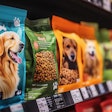
“Protein is the most financially and metabolically challenging category of pet food ingredients.” Jennifer Adolphe, PhD, senior nutritionist for Petcurean, ended her presentation at the Alltech One18 conference on May 22, 2018, with that bold statement, which she attributed to a fellow nutritionist and researcher from Canada, A. Kate Shoveller, PhD, of the Department of Biosciences at the University of Guelph.
Their reasoning? The current pet food trend of pushing protein levels ever higher may not be sustainable, for a variety of reasons, and research is lacking to understand the long-term effects on dog and cat health.
Are high pet food protein levels sustainable?
During her presentation, Adolphe emphasized that, while protein is one of the main macronutrients needed by pets — actually, the amino acids in protein ingredients are required by dogs and cats — it is not an ideal source of energy, unlike the other two macronutrients, carbohydrates and fats. Excess protein is stored in the body as fat, so today’s high-protein, dense pet foods could be contributing to rising pet obesity if pet owners overfeed them.
Or, excess protein — or again, the amino acids in it — is excreted as nitrogen, which can be harmful to the environment. Not to mention your lawn; Shoveller commented during a presentation at the American Feed Industry Association conference in January 2018 that this extra nitrogen in dogs’ urine turns beautiful green grass to yellow.
Another sustainability issue with the high levels of protein in pet foods, many of which are from animal sources, is that our industry is competing with the human food industry for such protein sources. As the global population of people and pets continues to increase, along with rising incomes that allow more people to eat meat-based proteins and, often, also feed them to their pets, some of those proteins may become scarce. And producing more livestock animals can lead to additional environmental problems.
Research needed to establish optimal levels of protein
Pet health poses another reason to question the high levels of protein so popular among consumers and pet food companies. Adolphe and Shoveller both stressed that we don’t know the optimal level of protein for dogs or cats. We do have minimum requirements, based on the Association of American Feed Control Officials (AAFCO) nutrition requirements for dogs and cats, but today’s pet foods often far exceed those.
For example, Adolphe compared the amount of daily protein for an adult, healthy dog under AAFCO requirements, 56 grams, to the as-fed amount in a dog food with a 20 percent protein level (62 grams) and one with 35 percent protein — a whopping 109 grams! Do we know if that’s healthy for dogs in the long run?
As with many areas of pet nutrition, more research is sorely needed. In her January presentation, Shoveller listed the research needs, saying that “if we had data on the amount of protein present, the amino acid profile of that protein, the relative amounts of anti-nutritional factors and their effects on digestibility and metabolic availability and the amino acid requirements of dogs and cats that we want to target — then we could determine the exact amount of available protein in a given ingredient and use this to formulate optimum diets for dogs and cats.”
That’s quite a tall order, particularly considering that there’s little funding for pet food research outside of the proprietary studies conducted or commissioned by large pet food companies. Shoveller did provide a possible approach forward. She and her colleagues in Canada did a paper on the regulatory environment around protein quality in human food, using protein digestibility-corrected amino acid score (PDCAAS), a method of evaluating the quality of a protein based on both the amino acid requirements of humans and their ability to digest it.
A few researchers at other universities have used the method to do studies in pet food. “As an industry, we can also apply a PDCAAS-type approach for complete diets and set criteria to categorize diets in terms of the quality of the source of protein — rather than just the amount of protein in the food,” Shoveller said.
To accomplish this, we need more data on the protein and amino acid requirements of dogs and cats under a variety of life stages and conditions (e.g., senior pets) to establish benchmarks, she added. We also need to know the effects of essential and non-essential nitrogen on health and well-being and the intersection among dietary nutrients, species/breeds and physiological state.
Tackling with consumer education, industry cooperation
That’s still a tall order, not to mention a difficult request to make of pet food companies and the industry overall when consumers continue to demand and buy pet foods with high protein levels, and want to feed their pets similarly to how they themselves are eating — which is also often focused on protein these days. That adds an element of complexity, as well as the need for further consumer education.
Yet this is likely an issue that our industry will need to confront and start to address someday, no matter the level of difficulty. We may simply run out of animal-based proteins.


















